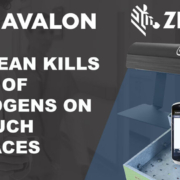In years past, infection control systems seemed to be reserved mostly for the healthcare field. Nevertheless, as more COVID-19 cases are reported amongst warehouses and distribution centers, the need for trustworthy and infallible infection control systems has become higher than ever. The question is no longer “if” but “how” you should develop a recurrent infection control system. In our commitment to enhancing operations, Avalon Integration continues in its investigation as to how we can halt germ spread without hindering your workforce’s overall productivity.
Clean. Sanitized. Disinfected. Understand the Difference.

From automated cleaning to disinfectant-ready surfaces, there are many options when it comes to creating a thorough cleaning solution. However, before any of these resources are selected, Avalon recommends understanding the crucial difference between your solution’s key aspects since these differences can do more than curb germ spread.
- Cleaning – As the first step of your infection control process, manual cleaning serves as the front line to germ mitigation, yet it is only a starting point. This step involves wiping down high-touch equipment from any visible grime and dust particles. This should be done whenever devices are utilized in dusty/dirty areas to avoid bringing foreign contaminants into the workplace.
- Disinfecting – Studies suggest there may be well over 3000 bacteria colonies residing on your handheld devices. Going beyond visible contaminants, proper disinfection strategies eliminate pathogenic microorganisms which are usually the perpetrators behind disease spread. A common disinfection solution can involve liquid chemicals, which if used inadequately can harm your mobile device. As a result, Avalon has worked with Zebra Technologies to provide disinfectant-ready hardware and specified cleaning guides that protect your device while accommodating your preferred disinfection strategy.
- Sterilizing – Last but not least, the Center of Disease Control and Prevention cites sterilization as the eradication of all microbial life, including bacterial spores which can survive thorough disinfection. Although complete eradication is not likely, experts still encourage facilities to strive towards 100% sterilization when possible. While this procedure may seem more demanding, it can be vital when dealing with shared devices since most pathogens are transmitted via touch. Because today’s warehouses are generally fast-paced environments, Avalon partners with Proximity to accelerate sterilization with UV-Clean, killing 99.99% of bacteria in less than five minutes by scrambling bacterial DNA with controlled UV-C rays. In doing so, you minimize potential illnesses as devices are shared across your workforce.
When implemented correctly, these steps can also stop cross-contamination and other traceability issues in addition to germ spread. Take a closer look into any of these steps when you contact our automation experts today for your free demonstration.


